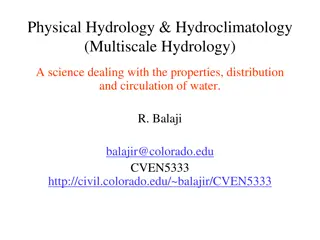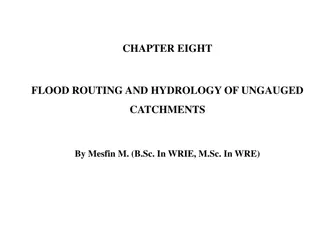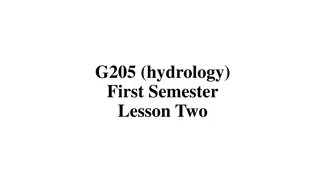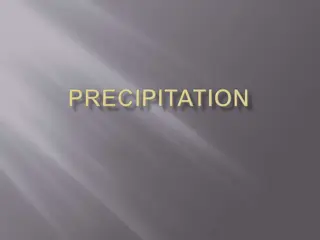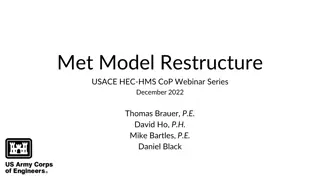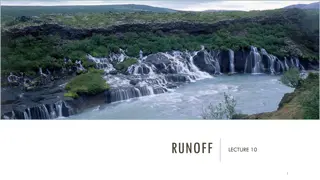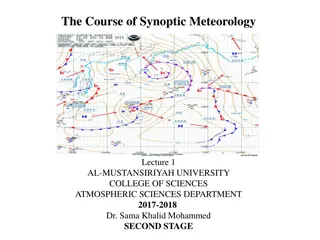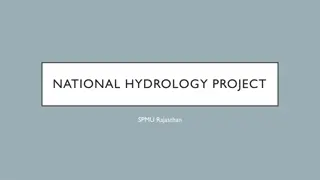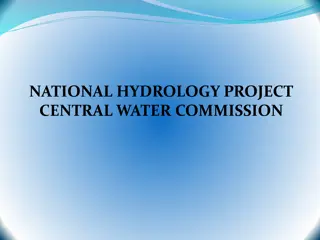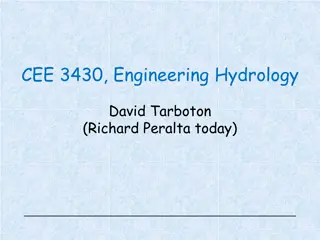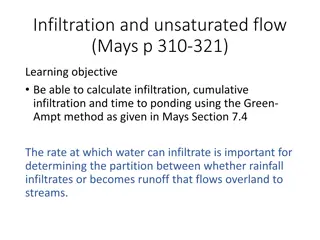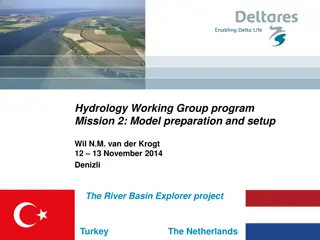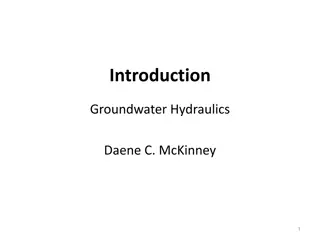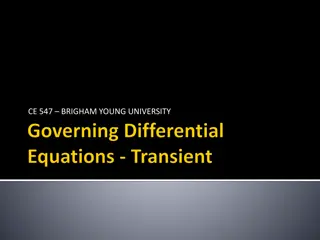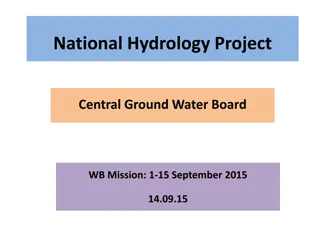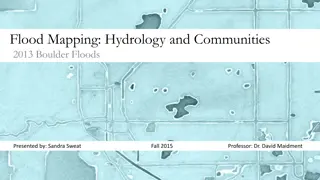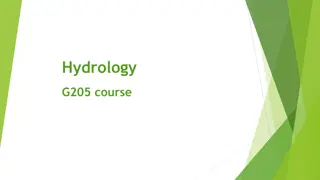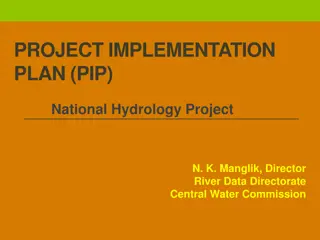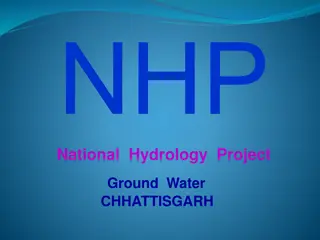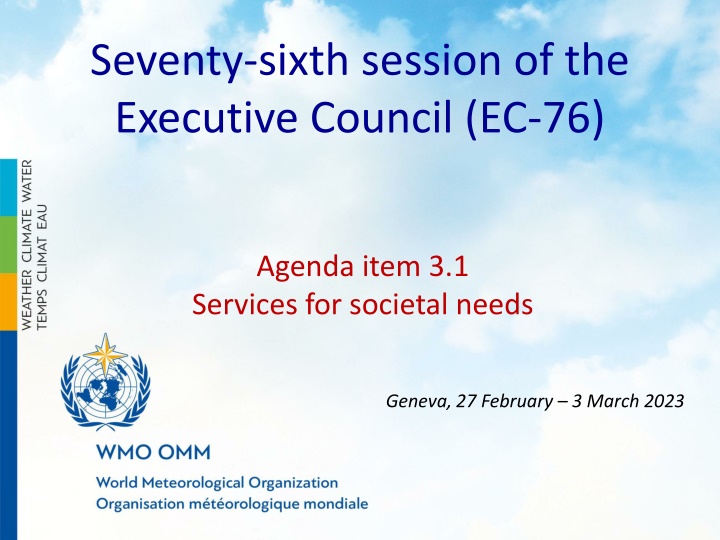
Review of Educational Standards in Meteorology and Hydrology
Revised guidelines for educational standards in meteorology and hydrology, including updates to the Basic Instructional Packages for meteorologists and meteorological technicians. The documents reviewed and recommended by the Executive Council Capacity Development Panel aim to establish qualifications for professionals in the field, reflecting the changing needs of the industry.
Download Presentation

Please find below an Image/Link to download the presentation.
The content on the website is provided AS IS for your information and personal use only. It may not be sold, licensed, or shared on other websites without obtaining consent from the author. If you encounter any issues during the download, it is possible that the publisher has removed the file from their server.
You are allowed to download the files provided on this website for personal or commercial use, subject to the condition that they are used lawfully. All files are the property of their respective owners.
The content on the website is provided AS IS for your information and personal use only. It may not be sold, licensed, or shared on other websites without obtaining consent from the author.
E N D
Presentation Transcript
Seventy-sixth session of the Executive Council (EC-76) Agenda item 3.1 Services for societal needs Geneva, 27 February 3 March 2023
Seventy-sixth session of the Executive Council (EC-76) EC-76/Doc. 3.1(3) Review of BIP-M and BIP-MT (Part VI and Appendix A of Vol. I) of the Technical Regulations (WMO- No.49) Geneva, 27 February 3 March 2023
General Considerations Revised Guide to the Implementation of Education and Training Standards in Meteorology and Hydrology, Volume I Meteorology (WMO-No.1083) Following Resolution32 (EC-70), the Basic Instructional Package for Meteorologists and the Basic Instructional Package for Meteorological Technicians (BIP-M and BIP-MT), was revised by a designated Review Team in close collaboration with the WMO Education and Training Office. The review process included extensive consultation with Members and carefully considered the flexibility of the packages to meet future needs in a rapidly evolving world. Review of BIP-M and BIP-MT (Part VI and Appendix A of Vol.I) of the Technical Regulations (WMO-No.49) BIP-M and BIP-MT (Part VI and Appendix A of Vol. I) of the Technical Regulations (WMO-No. 49) were updated to reflect the reviewed Guide. These were revised and recommended by the EC Capacity Development Panel (EC-CDP) in 2022, subsequently being presented to the WMO Technical Commissions, receiving their recommendations. The Guide presents the BIP-M and BIP-MT, establishing a common understanding of the qualifications required for individuals to be recognized as meteorologists or as meteorological technicians, as defined in the Technical Regulations (WMO-No.49).
From Review to Approval of WMO-No. 1083 and respective parts of WMO-No. 49 What stage are we now? Next Steps Completed Publication Presenting to EC-76 Presenting to Cg-19 Full Consultation and Updates Presenting to Commissions Presenting to EC-CDP From 2019 to 2021 surveys and meetings conducted to identify key requirements. Updated text distributed to WMO Technical Departments and Commissions, NMHSs, WMO RTCs, and ETR Partners of Global Campus for final reviews. Update presented at SYMET-14. The updated WMO- No.1083, which has been recommended by CDP, and resulting updates in WMO-No. 49 were presented to and recommended by SERCOM-2 and INFCOM-2 in November 2022. The updated WMO-No. 1083 is presented to EC for approval. The WMO-No. 49 is presented to EC for recommendation to Congress. The updated WMO-No. 49 will be presented to Congress for approval. The final draft of BIPs (WMO-No. 1083) was discussed and recommended by the Capacity Development Panel of EC (EC-CDP) in February 2022.
From Review to Approval of WMO-No. 1083 and respective parts of WMO-No. 49 Supporting Documents: Annex to Draft Resolution 3.1(3)/1 (EC-76) Guide to the Implementation of Education and Training Standards in Meteorology and Hydrology, Volume I Meteorology (WMO-No. 1083) Final draft recommended by CDP, SERCOM-2 and INFCOM-2. Annex to Draft Resolution # #/1 (Cg-19) Presenting to EC-76 Amendments to Technical Regulations, Volume I:General Meteorological The updated WMO-No. 1083 is presented to EC for approval. Standards and Recommended Practices (WMO-No. 49) Part VI and Appendix A - This draft contains the changes resulting from updates in The WMO-No. 49 is presented to EC for recommendation to Congress. WMO-No.1083, as recommended by CDP, SERCOM-2 and INFCOM-2.
Seventy-sixth session of the Executive Council (EC-76) EC-76/Doc. 3.1(11) Implementation Plan for the Methodology for Cataloguing Hazardous Events (WMO-CHE) with Annexes Geneva, 27 February 3 March 2023
EC-76/Doc. 3.1(11) Implementation Plan for the Methodology for Cataloguing Hazardous Events (WMO- CHE) with Annexes The Implementation Plan in response to: o Resolution 12 (Cg-18) WMO Methodology for Cataloguing Hazardous Weather, Climate, Water, and Space Weather Events o Resolution 2 (EC-73) - Implementation Plan outline for the methodology for cataloguing hazardous events o Recommendation 5.6(3)/1 (SERCOM-2) - Implementation Plan for the Methodology for Cataloguing Hazardous Events (WMO-CHE) with annexes The draft Implementation Plan includes: o A four-year demonstration project whereby WMO Members are requested to implement WMO Cataloguing of Hazardous Events (WMO-CHE) in coordination with their corresponding Regional Climate Centres (RCCs). o Within two years recommendations will be made to SERCOM and the Commission for Observation, Infrastructure, and Information Systems (INFCOM) on recommended changes to WMO technical regulations and/or guidelines to facilitate the national to global operationality of the WMO-CHE. In this working draft, interventions have been incorporated from Ethiopia, Iran, and USA Expected action: Review the proposed Implementation Plan and its annex and adopt Resolution 3.1(11)/1 (EC-76)
Seventy-sixth session of the Executive Council (EC-76) EC-76/Doc. 3.1(12) Global Multi-Hazard Alert System Framework Implementation Plan (WMO-GMAS) Geneva, 27 February 3 March 2023
EC-76/Doc. 3.1(12) Global Multi-Hazard Alert System Framework Implementation Plan (WMO-GMAS) The Implementation Plan in response to: o Resolution 5 (Cg-17) Secretary-General was requested to carry out the enhancement necessary to enable the Severe Weather Information Centre (SWIC) website to disseminate weather warnings that would be provided in Common Alerting Protocol (CAP) format by Members o Decision 6 (EC-68) EC adopted implementation of the Common Alerting Protocol o Decision 3 (EC-69) EC endorsed the initial draft vision of the WMO Global Multi-Hazard Alert System o Decision 4 (EC-70) EC requested the Working Group on Disaster Risk Reduction to gather additional user requirements to inform the development of the WMO GMAS o Resolution 13 (Cg-18) Cg agreed the development of the WMO Global Multi-Hazard Alert System Framework implementation plan o Resolution 1 (EC-71) - EC requested the President of SERCOM to lead the development of the GMAS Framework o Decision 8 (SERCOM-1) requested the SC-DRR to further refine the GMAS Framework Implementation Plan o Resolution 1 (RA 1 17), Resolution 12 (RA II-16), Decision 7 (RA III-17), Decision 4 (RA V-17), Resolution 3 (RA VI-17) Regional Associations guided the framing of the GMAS Framework Implementation Plan through the implementation of pilot projects and endorsement of GMAS related Resolutions and Decisions o Recommendation 5.6(4)/1 (SERCOM-2) - WMO GMAS Framework Implementation Plan The draft Implementation Plan includes: o A four-year demonstration project whereby WMO Members are requested to implement WMO Cataloguing of Hazardous Events (WMO-CHE) in coordination with their corresponding Regional Climate Centres (RCCs). o Within two years recommendations will be made to SERCOM and the Commission for Observation, Infrastructure, and Information Systems (INFCOM) on recommended changes to WMO technical regulations and/or guidelines to facilitate the national to global operationality of the WMO-CHE. In this working draft, interventions have been incorporated from UK Expected action: Review the proposed Implementation Plan and its annex and adopt Resolution 3.1(11)/1 (EC-76)
Seventy-sixth session of the Executive Council (EC-76) EC-76/Doc. 3.1(13) WMO Coordination Mechanism Implementation Plan Geneva, 27 February 3 March 2023
EC-76/Doc. 3.1(13) WMO Coordination Mechanisms Implementation Plan with Annexes The Implementation Plan in response to: o Resolution 14 (Cg-18) WMO Coordination Mechanism o Recommendation 5.6(5) (SERCOM-2) WMO Coordination Plan with annexes o Increasing demand for climate information / expert advice / data o Continuing need for WMO to support the work of our UN Humanitarian Partners Also noting: Additional recommendations made during SERCOM-2 (17 20 October 2022, Agenda Item 5.6) as noted in the Decides section of the draft recommendation (5.6(5)/1 (SERCOM-2)), which are addressed in Annex B to Draft Resolution EC-76/Doc. 3.1(13),
WCM will adhere to the terms of reference for UN Humanitarian interventions which are defined under UN resolution 46/182, through the agreed Terms of Reference of the UN Inter Agency Standing Committee (IASC) which is the principal UN humanitarian response and coordination body, or as defined under specific UN Security Council mandates The WCM Approval requested to fully develop WCM alongside the Implementation of the appropriate governance mechanisms
Seventy-sixth session of the Executive Council (EC-76) EC-76/Doc. 3.1(14) Multi-Hazard Early Warning Services Interoperable Environment Geneva, 27 February 3 March 2023
EC-76 - Doc 3.1(14)/1 (EC-76) Multi-Hazard Early Warning Services Interoperable Environment The Concept Note on Multi-Hazard Early Warning Services Interoperable Environment (CN-MIE) Framework has been developed in response to: Resolution 15 (Cg-18) Strengthening Multi-Hazard Early Warning Services in areas prone to all flooding types and severe weather The concept note includes following five sections: 1) Purpose (interoperability and integration of early warning initiatives, programmes, and activities as feasible into a coordinated and sustainable, multi-hazard interoperable environment, to enhance the capacities of national institutions involved in MHEWS with support from the regional level collaboration and coordination) 2) Background - Scope of Work, rationale, strategic vision and objective (WMO 2030 Vision and the Strategic Operating Plan, EW4A. By 2027, interoperability allows for the reliable and predictable transport of MHEWS-related data, metadata, and information across existing and future system boundaries)
EC-76 - Doc 3.1(14)/1 (EC-76) Multi-Hazard Early Warning Services Interoperable Environment 3) National and local requirements and capabilities in the context of MIE (EWS are the purview of national and local governments, although system operation and guidance delivery may be regional or global. Countries, based on their needs and realities, should adapt the MIE into the design of the national MHEWS implementation. That includes three main aspects, namely institutional/ governance, technical (data, tools and technology) and staff aspects (requirements of manpower, competencies and capacity building) 4) Regional requirements and capabilities to support national and local early warning services (This mainly include the roles and responsibilities of the regional centres. Two primary roles include (1) operational support to national level work, in data and product supply, and (2) Competencies, training and outreach) 5) Implementation and Next Steps (It highlights that MIE will not start from scratch. A number of countries are already covered by two or more of the FFGS, SWFP and TCP activities. Several countries, in different WMO Regional Associations, have implemented MHEWS incorporating all FFGS/SWFP/CIFI/ TCP activity areas. As a next step, development of implementation plan has been proposed in the concept note. It should include measures and activities that reply to gaps and needs as provided by analysis above targeting (1) institutional, (2) technical and technological, and (3) staff aspects.) The governance mechanism for the MIE framework has been proposed as part of the Doc 4(2)/1 (EC- 76) UN Early Warnings for All Initiative Follow-Up. ET-EWS will serve under the direction of SERCOM/SC-DRR, and its ToR includes, among others, to build on existing, and develop new guidance and supportive frameworks, where necessary, to cover gaps in hazards not currently addressed and extend the coverage of existing WMO Infrastructures including RSMCs, leveraging outcomes from the previous activities of the ET-MIE and ET-GMAS including but not limited to MIE Framework and GMAS implementation plan Expected Action: Review the draft concept note on MIE and adopt Resolution 3.1(14)/1 (EC-76) along with its annex (Concept note on MIE)
Seventy-sixth session of the Executive Council (EC-76) EC-76/Doc. 3.1(17) Cost Options Investigation Geneva, 27 February 3 March 2023
COST OPTIONS INVESTIGATION (EC-76/Doc. 3.1(17)) This Document presents the recommendations deduced from the Cost Options Investigation related to marine services; Recommendations were reported to SERCOM2 by SC- MMO (Recommendation 5.8(2)/1 (SERCOM-2)); SERCOM-2 endorsed the recommendations; The Cost Options Investigation report is provided as EC- 76/INF. 3.1(17)
Recommendation (EC-76/Doc. 3.1(17)) Recommends to the Congress to consider the recommendations resulting from the investigation as articulated in the annex to the present recommendation.
Thank you Merci
Background Cg-17 (general summary paragraph 3.1.132) requested co- president of JCOMM and WMO Secretary-General, in consultation with the IMO, to consider cost recovery processes for marine services; At Cg-18 Resolution 30 (Cg-18 Resolution 30) was adopted - further investigation was required together with the provision of advice to Members, on cost option models that could be considered; Congress requested consultations with relevant bodies, including IMO, and subsequent report to the EC with recommendations to be presented for consideration at Cg-19.
Process Total of 28 interviews conducted between march and June 2022; Breakdown: 24 coastal states, of which 10 were METAREA Coordinators 2 IGOs 2 industry stakeholder organizations 12 interview requests for which no reply received IMO was consulted in the process per request from Congress METAREA Coordinator costs not addressed; currently subject to separate IMO output Cost Options investigation report discussed and fully endorsed at SERCOM-2
The numbers of WMO Members interviewed in each Regional Association
SOLAS 1974, 2000 amendments extract, Chapter V, regulation 5 2. In particular, Contracting Governments undertake to carry out, in co-operation, the following meteorological arrangements: information in text and, as far as practicable graphic form, using the appropriate shore-based facilities for terrestrial and space radiocommunications services. .1 to warn ships of gales, storms and tropical cyclones by the issue of services, as appropriate, weather information suitable for shipping containing data, analyses, warnings and forecasts of weather, waves and ice. Such information shall be transmitted in text and, as far as practicable, graphic form including meteorological analysis and prognosis charts or in digital form for reconstitution on board the ship's data system .2 to issue, at least twice daily, by terrestrial and space radiocommunication transmitted by facsimile processing and to ships, using the appropriate shore-based facilities for terrestrial and space radiocommunications services. .8 to arrange for the reception and transmission of weather messages from
Comparative studies of the aviation industry and other maritime income generating proposals Not one-to-one relationship, information promulgated by wide area broadcast WMO, as a technical body, cannot enforce regulations only provides guidance Not possible to track every vessel passing through state's waters, therefore difficult to identify customer for income generating purpose One-to-one relationship between customer and service provider ICAO has power to enforce regulations Possible to monitor and track every aircraft entering airspace Maritime Industry Aviation Industry There are significant differences between aviation and marine, therefore any comparison on operations and methodologies is challenging and potentially misleading.
Thank you Merci

